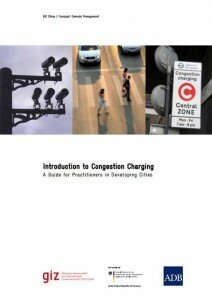 With the Clean Air Action Plan of 2013 Beijing started the discussion on introducing congestion charging to reduce traffic volume, relieve congestion and subsequently transport related air pollution. With the support of GIZ, the Beijing Transportation Research Centre modelled the impact of different congestion charging policy schemes.
With the Clean Air Action Plan of 2013 Beijing started the discussion on introducing congestion charging to reduce traffic volume, relieve congestion and subsequently transport related air pollution. With the support of GIZ, the Beijing Transportation Research Centre modelled the impact of different congestion charging policy schemes.
While Beijing is still discussing the feasibility of congestion charging, few prominent cities around the world have implemented it. Stockholm, London, Singapore, Milan are some of the cities that are currently operating a congestion charging scheme as an economic instrument to reduce congestion and its detrimental effects. Forty years after its first implementation, congestion charging remains a highly underused policy, even if implemented policies have shown to be highly successful. The international experts involved in assessing the congestion charging policy for Beijing have summarised their experience with congestion charging in a policy guide. The guide attempts to address the two main reasons why congestion charging remains a uncommon policy instrument.
Firstly, even though sufficient research and best practices exist, it may not have found its way to policy makers in a concise way. In line with this, political acceptance and support is often difficult to obtain, especially in the early stages of scheme definition and development.
For example, Stockholm has faced massive public resistance just before implementation. The approval rate is now at around 70% a couple of years after implementation.
Secondly, in the traditional planning of new infrastructure, predetermined decision-making processes are often in place to ensure that proper procedures are followed. These procedures may even be embedded in legislation and may include components like public outreach, environmental effects studies, design studies, etc. However, for the planning of congestion charging, these processes are often only vaguely defined. The transfer of a conceptual idea into a solid and feasible policy remains unclear. This is one of the reasons why cities like New York and Manchester have not managed to come from a feasible concept to a implementable policy.
Structured around these two themes, this guide is split into modules. Readers can choose those chapters that may appeal to them, depending on how far the idea of congestion charging has matured in the city of interest. Throughout the documents practical examples are given, common mistakes explained, pre-requisites for this charge defined.
Chapter one explains the theoretical economic background and displays empirical data to demonstrate that congestion charging can help to ease traffic congestion while achieving several other co-benefits.
Chapter two addresses factors that may obstruct congestion charge implementation. This includes examples on how to handle privacy and equity issues, general averseness of decision makers or scepticism towards the effectiveness of the system.
The third chapter considers the actual congestion charge implementation. It discusses the policy design process and the key features of a feasibility study. Practical examples and recommendations are given towards the functional, technical, legal and organisational design. After discussing the legal framework, chapter four focuses on choosing models in the decision making process. Forecasting, analysing and discussing potential design is actually the core of developing successful charging policies. Both politicians and transportation engineers tend to overestimate their competence in understanding the transportation system and their ability to propose a good congestion charging design. This is why a single chapter in this guide is devoted just to the model based design of charging policies. In the fifth chapter equity factors of congestion charging are discussed. Examples are given on how to use revenues in investing in public transport infrastructure, implementing and adopting discounts or exemptions and how they may contribute to raise acceptance levels. Chapter six is concentrating on the technological backgrounds of different congestion charge systems.
In Beijing, the effects of various fare levels and zones sizes have been assessed in respect to their emission reduction potential. The emission model has been jointly developed by GIZ and the Swiss INFRAS institute.
Download the congestion charging guide:
English
中文 (Chinese)
See a Prezi about congestion charging here.
For more information on the emission model click here.
The guide is jointly published by the Deutsche Gesellschaft für Internationale Zusammenarbeit (GIZ) GmbH and the Asian Development Bank (ADB) in the context of the Transport Demand Management project financed through the German Federal Ministry for the Environment, Nature Conservation, Building and Nuclear Safety.


